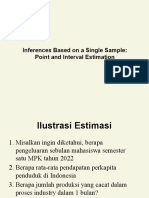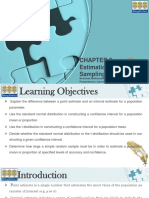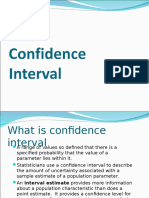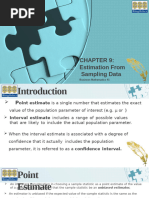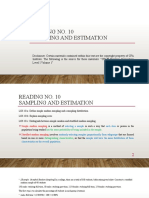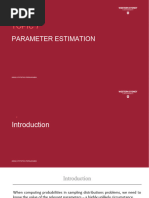Topic 5
Topic 5
Uploaded by
eddyyowCopyright:
Available Formats
Topic 5
Topic 5
Uploaded by
eddyyowCopyright
Available Formats
Share this document
Did you find this document useful?
Is this content inappropriate?
Copyright:
Available Formats
Topic 5
Topic 5
Uploaded by
eddyyowCopyright:
Available Formats
Topic 5 Topic: Estimation and Confidence Interval
• Estimation & Confidence Interval for • To construct a confidence
Population Mean with Known Σ interval for a population
• Confidence Interval for Population Mean mean with known σ
with Unknown σ • To construct a confidence
• Confidence Interval for Population interval for a population
Proportion mean with unknown σ
• Determining the Sample Size • To construct a confidence
interval for a population
proportion
Why This Topic
Estimation is a procedure by which a numerical value or values are assigned to a population parameter based
on the information collected from a sample. The statistical procedures for estimating the population mean,
proportion, variance, and standard deviation will be explained. This lesson explains how to construct a
confidence interval for the population mean μ when the population standard deviation σ is known, unknown
and for a population proportion.
Estimation & Confidence Interval for Population Mean with Known Σ
Point Estimation
A point estimate is a single value that best describes the population of interest:
• The sample mean is a point estimate of the unknown population mean.
• The sample proportion is a point estimate of the unknown population proportion.
Point estimates are easy to calculate but do not provide any information about their accuracy.
An interval estimate provides additional information about variability.
Confidence Intervals
Calculating Confidence Intervals for the Mean when the Standard Deviation (σ) of a Population is Known
A confidence interval for the mean is an interval estimate around a sample mean that provides us with a range
within which the true population mean is expected to lie.
© UNITAR International University Page 1 of 11
A confidence level is defined as the probability that the interval estimate will include the population parameter
of interest.
Assumptions :
• The sample size is at least 30 (n ≥ 30).
• The population standard deviation (σ) is known.
The formula for the Standard Error of the Mean
The purpose of generating a confidence interval is to provide an estimate of the value of the population mean.
The confidence interval for the mean has an upper confidence limit and a lower confidence limit. The limits
describe the range in which we have some degree of confidence that the actual population mean lies.
Formulas for the Confidence Interval for the Mean (σ Known)
zα/2 is called the critical z-score.
The variable α is known as the significance level; it represents the probability that any given confidence interval
will not contain the true population mean.
Example: if α = 0.10, then zα/2 = z0.05 = 1.645 is the value that encloses 90% of the area under the normal distribution
and leaves 5% in each tail.
• The total area to the left of the right-hand boundary is 0.90 + 0.05 = 0.95.
• The total area to the left of the left-hand boundary is 0.05.
© UNITAR International University Page 2 of 11
Example: An airline wants to estimate the number of tickets sold for a daily flight between Dallas and Denver.
Suppose a sample of 35 flights gives a sample mean of 145.5 (Assume that σ = 30.2).
Calculate a 90% confidence interval for the population mean:
1. Find the standard error of the mean:
2. Find zα/2 for 90%:
3. Calculate the interval endpoints:
Based on our sample mean of 145.5, we are 90% confident that the population mean number of tickets sold is
between 137.10 and 153.90.
Calculating the Margin of Error
The Margin of Error ME is the width of the confidence interval between a sample mean and its upper limit or
between a sample mean and its lower limit.
© UNITAR International University Page 3 of 11
Increasing the sample size while keeping the confidence level constant will reduce the margin of error, resulting
in a narrower (more precise) confidence interval.
Interpreting a Confidence Interval
We are 90% confident that the true mean is between 137.10 and 153.90.
• Although the population mean may or may not be in this interval, close to 90% of a large number of
sample means drawn from this population will produce confidence intervals that include that
population’s mean.
An incorrect interpretation is that there is 90% probability that this interval contains the true population mean.
• This interval either does or does not contain the true mean, there is no probability for a single interval.
© UNITAR International University Page 4 of 11
Changing Confidence Levels
The significance level, α, represents the probability that any given confidence interval will not contain the true
population mean.
The confidence level of an interval is the complement to the significance level, 1 ─ α.
• i.e., a 100(1 – α)% confidence interval has a significance level equal to α.
The confidence interval gets wider if the confidence level increases.
z-scores for the most commonly used confidence levels are shown in this table:
© UNITAR International University Page 5 of 11
Confidence Intervals for the Mean with Small Samples when σ is Known. When the sample size is less than 30 and
sigma is known, the population must be normally distributed to calculate a confidence interval. With n < 30 the
Central Limit Theorem cannot be applied, so we can’t say the sampling distribution will be approximately
normal…
• …but the sampling distribution is always normal (regardless of sample size) if the population is normally
distributed.
Example: A manager wants to know the average time it takes to complete the required forms to hire a new
worker. Suppose a sample of size n = 18 gives a sample mean of 1.28 hours (assume that σ = 0.2 hours and that
the population follows the normal distribution).
Calculate a 95% confidence interval for the population mean.
1. Find the standard error of the mean:
2. Find zα/2 for 95%:
3. Calculate the interval endpoints:
Confidence Interval for Population Mean with Unknown σ
When the population standard deviation is unknown, we substitute s, the sample standard deviation, in its place
to calculate the standard error.
© UNITAR International University Page 6 of 11
The formula for the Approximate Standard Error of the Mean
The Student’s t-distribution is used in place of the normal probability distribution when the sample standard
deviation, s, is used in place of the population standard deviation, σ.
Using the Student’s t-distribution
The t-distribution is a continuous probability distribution with the following properties:
• It is bell-shaped and symmetrical around the mean.
• The shape of the curve depends on the degrees of freedom (df), df = n – 1.
• The area under the curve is equal to 1.0.
• The t-distribution is flatter and wider than the normal distribution.
• The critical score for the t-distribution is greater than the critical z-score for the same confidence level.
• The t-distribution is actually a family of distributions. As the number of degrees of freedom increases, the
shape of the t-distribution becomes similar to the normal distribution.
Note: When there are more than 100 degrees of freedom (a sample size of more than 100), the t-distribution and
normal distribution are practically identical.
Formulas for the Confidence Interval for the Mean (σ Unknown)
© UNITAR International University Page 7 of 11
Example: A hospital manager wants to estimate the average number of days patients spend in the hospital for
a surgical procedure. Suppose a sample of size n = 15 has a sample mean of 5.11 and a sample standard
deviation s = 0.85.
Calculate a 95% confidence interval for the population mean.
1. Find the standard error of the mean:
2. Find tα/2 for (15 – 1) = 14 df and 95% confidence (from Student’s t table):
3. Calculate the interval endpoints:
Based on our sample mean of 5.11, we are 95% confident that the population mean is between 4.64 and 5.58
days.
Confidence Interval for Population Proportion
Calculating Confidence Intervals for Proportions
Proportion data follow the binomial distribution, which can be approximated by the normal distribution under the
following conditions:
np ≥ 5 and n(1 – p) ≥ 5
where:
p = The probability of a success in the population
n = The sample size
© UNITAR International University Page 8 of 11
The confidence interval for the proportion is an interval estimate around a sample proportion that provides us
with a range of where the true population proportion lies.
Since the population proportion p is unknown, it is estimated using the sample proportion. The formula for the
Approximate Standard Error of the Proportion:
Formulas for the Confidence Interval for a Proportion:
The formula for the Margin of Error for a Confidence Interval for the Proportion
© UNITAR International University Page 9 of 11
The proportion margin of error, MEp, represents the width of the confidence interval between the sample
proportion and its upper limit or between the sample proportion and its lower limit
Example: From a random sample of Malaysian citizens, 22 of 100 people are found to have diabetes. Calculate
a 98% confidence interval for the population proportion of diabetic Malaysian citizens.
1. Calculate the sample proportion and the approximate standard error of the proportion:
2. Find zα/2 for 98%:
3. Calculate the interval endpoints: (next slide)
Based on our sample proportion of 0.22, we are 98% confident that the population proportion is between 0.124
and 0.316
Determining the Sample Size
Determining the Sample Size
Increasing the sample size, and holding all else constant, reduces the margin of error and provides a narrower
confidence interval.
The sample size needed to achieve a specific margin of error can be calculated, given the following information:
• The confidence level
• The population standard deviation
Calculating the Sample Size to Estimate a Population Mean
Solving for n:
© UNITAR International University Page 10 of 11
Example: If σ = 45, what sample size is needed to be 90% confident in estimating the population mean with a
margin of error of ± 5?
1. Find zα/2 for 90%:
2.
3. Calculate the required sample size:
So use a sample of size n = 220 (always round up).
- end of content –
© UNITAR International University Page 11 of 11
You might also like
- Parametric - Statistical Analysis PDFDocument412 pagesParametric - Statistical Analysis PDFNaive Manila100% (2)
- Chapter 09 PowerPointDocument26 pagesChapter 09 PowerPointElgün HaqverdiyevNo ratings yet
- CIForMean LargeSample ActivityDocument8 pagesCIForMean LargeSample ActivityrgerergNo ratings yet
- EstimationsDocument24 pagesEstimationsnansambada2021No ratings yet
- Materi 4 Estimasi Titik Dan Interval-EditDocument73 pagesMateri 4 Estimasi Titik Dan Interval-EditHendra SamanthaNo ratings yet
- 5.1 Lesson 5 T-Distribution - A LectureDocument5 pages5.1 Lesson 5 T-Distribution - A LectureEdrian Ranjo Guerrero100% (1)
- Estimation 1920Document51 pagesEstimation 1920Marvin C. NarvaezNo ratings yet
- Chapter 9 Estimation From Sampling DataDocument23 pagesChapter 9 Estimation From Sampling Datalana del reyNo ratings yet
- Chapter 3Document40 pagesChapter 3allahgodallah1992No ratings yet
- Confidence IntervalDocument54 pagesConfidence Intervalarchie.noblezaNo ratings yet
- Chapter 8Document15 pagesChapter 8Phước NgọcNo ratings yet
- BSCHAPTER - (Theory of Estimations)Document39 pagesBSCHAPTER - (Theory of Estimations)kunal kabraNo ratings yet
- Business Analytics Module 2 SummaryDocument3 pagesBusiness Analytics Module 2 SummaryhomairatasnimalamNo ratings yet
- 4estimation and Hypothesis Testing (DB) (Compatibility Mode)Document170 pages4estimation and Hypothesis Testing (DB) (Compatibility Mode)Mekonnen BatiNo ratings yet
- Chap 9Document9 pagesChap 9sastfNo ratings yet
- EstimationDocument44 pagesEstimationMarvin C. NarvaezNo ratings yet
- Inferential PDFDocument9 pagesInferential PDFLuis MolinaNo ratings yet
- CHAPTER 8 Interval EstimationDocument8 pagesCHAPTER 8 Interval EstimationPark MinaNo ratings yet
- Confidence IntervalDocument19 pagesConfidence IntervalAjinkya Adhikari100% (1)
- unit 2 part - 2Document38 pagesunit 2 part - 2shivamskashyapNo ratings yet
- Chapter 8 Confidence IntervalsDocument34 pagesChapter 8 Confidence Intervalsmriaz3No ratings yet
- Confidence Intervals NotesDocument12 pagesConfidence Intervals NotesakshuNo ratings yet
- Chapter 9 Estimation From Sampling DataDocument22 pagesChapter 9 Estimation From Sampling Datalumber jackNo ratings yet
- Lecture Notes Ch8 2022FDocument26 pagesLecture Notes Ch8 2022FJonathan CarcamoNo ratings yet
- Binomial Distributions For Sample CountsDocument38 pagesBinomial Distributions For Sample CountsVishnu VenugopalNo ratings yet
- EstimationDocument25 pagesEstimationyaminis.0223No ratings yet
- Confidence IntervalDocument19 pagesConfidence IntervalCarl LagusNo ratings yet
- Acc117 Chapter5 ReportDocument47 pagesAcc117 Chapter5 ReportJohny balanceNo ratings yet
- 2 Parametric Test Part IDocument120 pages2 Parametric Test Part IeiraNo ratings yet
- 1 Review of Basic Concepts - Interval EstimationDocument4 pages1 Review of Basic Concepts - Interval EstimationTiffany OrNo ratings yet
- Sampling and EstimationDocument20 pagesSampling and EstimationAbhitha JayavelNo ratings yet
- Chap 009Document25 pagesChap 009Ayman IbnatNo ratings yet
- Revision SB Chap 8 12 Updated 1Document44 pagesRevision SB Chap 8 12 Updated 1Ngan DinhNo ratings yet
- C08 Sampling Distributions and Estimation AKDocument7 pagesC08 Sampling Distributions and Estimation AKHuy LýNo ratings yet
- Statistics Chapter2Document102 pagesStatistics Chapter2Zhiye TangNo ratings yet
- 9a BMGT 220 S.I. Theory of EstimationDocument5 pages9a BMGT 220 S.I. Theory of EstimationPamela ChimwaniNo ratings yet
- Application of Ststs in Business, Notes-Ch8Document6 pagesApplication of Ststs in Business, Notes-Ch8minwooJingNo ratings yet
- stat 2 unit 2 (1)Document18 pagesstat 2 unit 2 (1)tayto.mindahunNo ratings yet
- Chapter 9 SlidesDocument33 pagesChapter 9 SlidesNoor FatimaNo ratings yet
- Unit 6 - Generalizing From A Sample To A PopulationDocument30 pagesUnit 6 - Generalizing From A Sample To A PopulationApril VelascoNo ratings yet
- Module 06 - One Population Parameter Estimation - Topic 4ADocument59 pagesModule 06 - One Population Parameter Estimation - Topic 4ADo Huyen Thy DongNo ratings yet
- Basic Statistics 7 Probability and Confidence IntervalsDocument22 pagesBasic Statistics 7 Probability and Confidence IntervalsMegadeth ShawonNo ratings yet
- Module 06 - One Population Parameter Estimation - Topic 4ADocument9 pagesModule 06 - One Population Parameter Estimation - Topic 4ADo Huyen Thy DongNo ratings yet
- Inferential Statistics: Estimation and Confidence IntervalsDocument19 pagesInferential Statistics: Estimation and Confidence IntervalsHasan HubailNo ratings yet
- Estimation of Population Parameters: 1) Estimating The Population MeanDocument19 pagesEstimation of Population Parameters: 1) Estimating The Population MeanLaxmish PrakashNo ratings yet
- Estimation and Sample Size DeterminationDocument37 pagesEstimation and Sample Size Determinationrafatanha804No ratings yet
- Chapter 9Document20 pagesChapter 9t524qjc9bvNo ratings yet
- Confidence+Interval+Estimate+for+Population+Mean (1)Document13 pagesConfidence+Interval+Estimate+for+Population+Mean (1)kcabanag18No ratings yet
- Inferences Based On A Single Sample: Confidence Intervals and Tests of Hypothesis (9 Hours)Document71 pagesInferences Based On A Single Sample: Confidence Intervals and Tests of Hypothesis (9 Hours)Kato AkikoNo ratings yet
- Estimtion Confidence IntervalDocument46 pagesEstimtion Confidence Intervalsakibulislam1600758No ratings yet
- C 4Document61 pagesC 4minhchauNo ratings yet
- Confidence IntervalsDocument50 pagesConfidence IntervalsDr. POONAM KAUSHALNo ratings yet
- Inferential EstimationDocument74 pagesInferential EstimationAbrham Belay100% (1)
- Lecture 24 PDFDocument12 pagesLecture 24 PDFAnonymous 7HfJimvNo ratings yet
- PSUnit IV Lesson 2 Understanding Confidence Interval Estimates For The Sample MeanDocument18 pagesPSUnit IV Lesson 2 Understanding Confidence Interval Estimates For The Sample MeanKen WunNo ratings yet
- Understanding Confidence Interval Estimates For The Sample MeanDocument18 pagesUnderstanding Confidence Interval Estimates For The Sample MeanJaneth MarcelinoNo ratings yet
- Chapter FourDocument9 pagesChapter FourTadele BekeleNo ratings yet
- Session 10 & 11 - EstimationDocument31 pagesSession 10 & 11 - EstimationMona LisaNo ratings yet
- Chap5 Estimation UploadDocument50 pagesChap5 Estimation UploadQuangtue NguyenNo ratings yet
- 8NUBIOEPISampleSIzeESTIMATION2T24-25FINALDocument25 pages8NUBIOEPISampleSIzeESTIMATION2T24-25FINALCyril TamioNo ratings yet
- Topic 1 Part BDocument9 pagesTopic 1 Part BeddyyowNo ratings yet
- Topic 1 Part ADocument4 pagesTopic 1 Part AeddyyowNo ratings yet
- Topic 2Document6 pagesTopic 2eddyyowNo ratings yet
- BADB1014 QM Hypothesis Testing Examples of Comparing 2 Means 2Document4 pagesBADB1014 QM Hypothesis Testing Examples of Comparing 2 Means 2eddyyowNo ratings yet
- Channel Restoration Design For Meandering RiversDocument454 pagesChannel Restoration Design For Meandering Riverscemkoc50% (2)
- Parasites SanguinsDocument14 pagesParasites Sanguinsmebarki mohamedNo ratings yet
- Statistics Unit 9 NotesDocument10 pagesStatistics Unit 9 NotesgopscharanNo ratings yet
- Download Full Elementary Statistics in Social Research, Updated Edition 12th Edition (eBook PDF) PDF All ChaptersDocument51 pagesDownload Full Elementary Statistics in Social Research, Updated Edition 12th Edition (eBook PDF) PDF All Chaptershorjakthlibi100% (2)
- Metoda 9308-3Document6 pagesMetoda 9308-3horia96No ratings yet
- SamplingDocument27 pagesSamplingApril ErinNo ratings yet
- FinQuiz - Item-Set Questions, Study Session 2, Reading 4 PDFDocument30 pagesFinQuiz - Item-Set Questions, Study Session 2, Reading 4 PDFAriyaNo ratings yet
- Probability in Computer ScienceDocument353 pagesProbability in Computer ScienceDavid James100% (1)
- Topic 4Document20 pagesTopic 4h.shelbayhNo ratings yet
- Business Analytics Module 6Document47 pagesBusiness Analytics Module 6Adoree RamosNo ratings yet
- Psychological Statistics ReviewerDocument11 pagesPsychological Statistics ReviewerLykaNo ratings yet
- Business Analytics Fundamentals Syllabus PDFDocument4 pagesBusiness Analytics Fundamentals Syllabus PDFKUSH PANDITNo ratings yet
- Important QuestionsDocument11 pagesImportant QuestionsRajan JattNo ratings yet
- Biomechanical Effects of Wearing High-Heeled Shoes: Chang-Min Lee, Eun-Hee Jeong, Andris FreivaldsDocument6 pagesBiomechanical Effects of Wearing High-Heeled Shoes: Chang-Min Lee, Eun-Hee Jeong, Andris FreivaldsSilviSilvaniaNo ratings yet
- 2013-Validation of The Soleris NF-TVC Method For Determination of Total Viable Count in A Variety of Foods - AOAC PTM - 071203Document5 pages2013-Validation of The Soleris NF-TVC Method For Determination of Total Viable Count in A Variety of Foods - AOAC PTM - 071203jasminetsai421No ratings yet
- Ch13 SamplingDocument20 pagesCh13 SamplingMd Hamid Ullah Bhuian 1310851630No ratings yet
- Calculating and Interpreting Interval Estimates For Population ProportionDocument3 pagesCalculating and Interpreting Interval Estimates For Population ProportionDania Bandojo100% (1)
- TMH 8 Traffic Monitoring Procedures CD2Document146 pagesTMH 8 Traffic Monitoring Procedures CD2thorisho.ngubaneNo ratings yet
- Box, Wetz Technical Report PDFDocument95 pagesBox, Wetz Technical Report PDFluciaf_alves8542No ratings yet
- Friday, August 16, 2019 8:20 PM: Final Test Page 1Document4 pagesFriday, August 16, 2019 8:20 PM: Final Test Page 1Huy Khang NguyễnNo ratings yet
- How To Calculate Sample Size - 14 Steps (With Pictures) - WikihowDocument6 pagesHow To Calculate Sample Size - 14 Steps (With Pictures) - Wikihowgamea2188No ratings yet
- Work Measurement-Compressed VersionDocument48 pagesWork Measurement-Compressed VersionL.a. LadoresNo ratings yet
- Homework 2: QRA in Safety EngineeringDocument12 pagesHomework 2: QRA in Safety Engineeringmohaned faisalNo ratings yet
- Six Sigma Session9 27022021 WILP BITS PILANI 1613825883729Document62 pagesSix Sigma Session9 27022021 WILP BITS PILANI 1613825883729FUNTV5100% (1)
- ST 544: Applied Categorical Data Analysis: Daowen ZhangDocument514 pagesST 544: Applied Categorical Data Analysis: Daowen ZhangOchieng WilberforceNo ratings yet
- 1 s2.0 S2352551720301621 MainDocument15 pages1 s2.0 S2352551720301621 MainadrianaNo ratings yet
- Systems Analysis & Design: Tenth EditionDocument60 pagesSystems Analysis & Design: Tenth EditionThảo Thanh100% (1)
- Nabl 174Document37 pagesNabl 174Sharath KarnatiNo ratings yet
- Problems-1. Solutions 1-10Document17 pagesProblems-1. Solutions 1-10Luca VanzNo ratings yet




